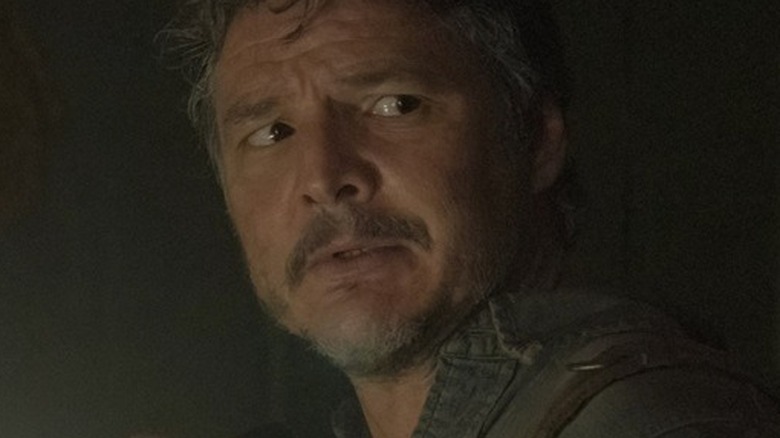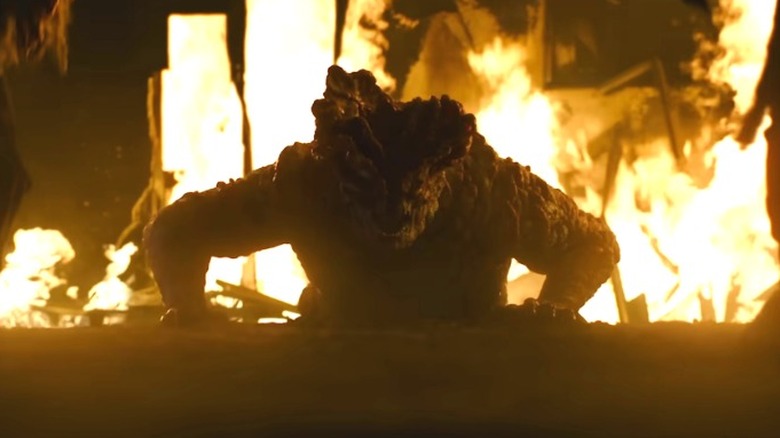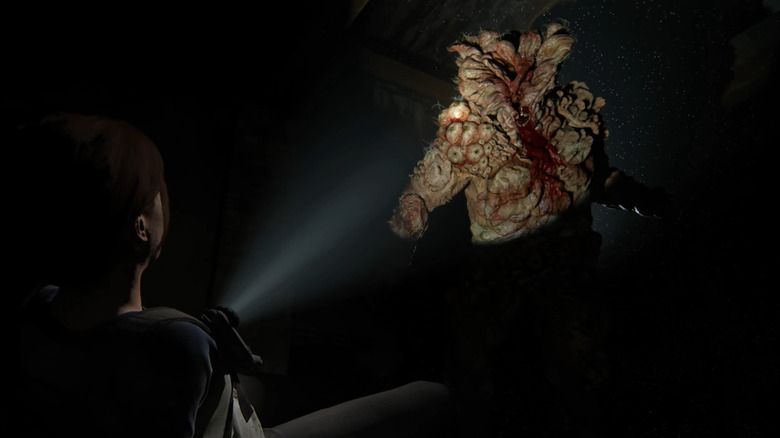The Bloater From The Last Of Us Trailer Explained
We're mere days away from the world ending and having to walk through the aftermath with Pedro Pascal and Bella Ramsay in HBO's highly anticipated show, "The Last of Us." Created by Neil Druckmann (the brains behind the original game the show is based on) and Craig Mazin of unsettling drama, "Chernobyl," what we've seen so far promises to be a close adaptation to one of the most beloved games of all time. From its heroes to its villains and everything in between, there appears to be plenty for fans to get giddy about, including one of the game's most lethal threats.
Now there's plenty to keep your guard up in this intense barren land at the world's end. Besides others fighting for survival, the horde of infected spread the disease that has nearly erased humanity, replacing them with carriers that have undergone a horrific transformation. The longer they live with the disease, the more their appearance fades behind a mutation that turns them into grotesque creatures that use sound to find their prey. This stage turns them into what are known as Clickers because of the sound they make. They're also tough to kill, but nothing compared to the final horrendous stage of the disease that turns them into something we've only caught a glimpse of: Bloaters.
Bloaters are the big bad beasts of The Last of Us
Sometimes a transformation into a bloodthirsty monster can take its time, sending the carrier through various phases the longer they succumb to it. In the case of cordyceps infection, there are four known stages to the disease, with the final step turning the victim into a Bloater. After the carrier has had the condition verging on years, the fungal plates go beyond the face and neck area you see on Clickers and overrun the entire body. Turning them into a walking, warring mushroom with poor posture.
A Bloater stands between Vladimir Harkonnen from "Dune" and a toadstool patch, shuffling along until it senses someone nearby to run at and rip to pieces. Harder to kill than a Clicker, the fungal plates act as an almost natural armor, making them harder to take down without heavy firepower. Those in the previous phase are tough to kill as it is, but a Bloater is like a freight train made of fungus that not only is a danger at close range but can cause damage with something lower-level infected don't have, which is a blessing ... kind of?
Bloaters are a toxic-level upgrade that few can escape
If screaming juggernaut-like monsters didn't make Bloaters bad enough, the extra unwanted bonus they have are detachable mycotoxin pouches that they throw like grenades. These multi-purpose pustules explode on impact, spraying a toxin that is lethal to anyone nearby. So even if you've managed to get the icky goo off your favorite flannel shirt, chances are the Bloater has gotten to you in time to rip your head clean off your person. Efficient.
So what puts this kind of infected enforcer down permanently? Well, if experience from the game confirms anything, fire will be the winning formula to take it down. Shotguns and high-powered weaponry might do the trick, but like any classic horror monster, it turns out that an excellent old-fashioned molotov cocktail will check the necessary box. The only issue is that judging by the trailer tease, the live-action Bloater is surrounded by the stuff, so will it be enough to bring this one down? Or will Pedro Pascal's Joel have to resort to more intense methods to take it out of the equation? We can only wait and see when "The Last of Us" hits HBO Max on January 15.


